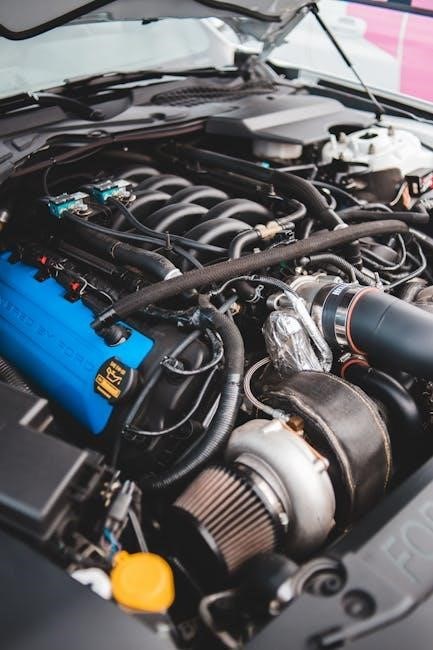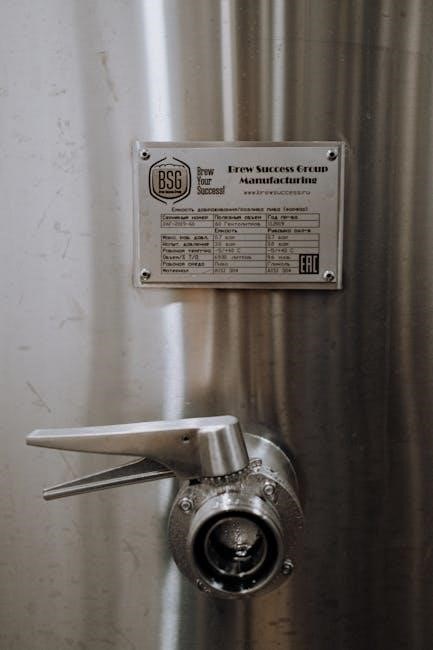engine valve guide
Discover expert solutions, tips, and maintenance advice for engine valve guides. Enhance performance and longevity with our comprehensive guide.
Engine valve guides are critical components ensuring proper valve stem alignment, maintaining engine performance, and longevity. They play a vital role in combustion chamber integrity and efficient sealing, preventing oil seepage and excessive smoke emissions. Understanding their function is essential for diagnosing and maintaining engine health effectively.
1.1 Overview of Engine Valve Guides
Engine valve guides are cylindrical components located in the cylinder head, responsible for aligning valve stems and preventing sideways movement. They are typically made from durable materials like bronze or steel to withstand high engine temperatures and wear. Properly fitted guides ensure efficient valve operation, preventing oil leakage into combustion chambers and reducing smoke emissions. Their design is crucial for maintaining engine performance and longevity.
1.2 Importance of Valve Guides in Engine Performance
Valve guides are essential for maintaining engine efficiency and preventing premature wear. They ensure proper valve alignment, preventing oil leakage into combustion chambers and reducing smoke emissions. Guides also minimize wear on valve stems, promoting consistent engine performance. Without functioning guides, engines may experience reduced power, increased oil consumption, and potential damage to valves and cylinder heads, leading to costly repairs and shortened engine lifespan.

Components of an Engine Valve Guide
Engine valve guides typically consist of a cylindrical sleeve, often made from durable materials like manganese bronze or cast iron, designed to house the valve stem. The guide bore ensures precise alignment, while the seating area provides a secure fit within the engine’s cylinder head, ensuring smooth operation and longevity.
2.1 Structure and Design of Valve Guides
Valve guides are typically cylindrical sleeves designed to fit precisely within the engine’s cylinder head. They feature a smooth, wear-resistant inner surface to guide the valve stem and a chamfered outer edge for proper seating. The guide’s bore is machined to exact tolerances to ensure alignment accuracy. Materials like manganese bronze or cast iron are often used for durability and heat resistance, with some designs incorporating surface coatings or hardness treatments to enhance longevity and reduce wear.
2.2 Materials Used in Valve Guide Construction
Valve guides are typically made from durable materials such as manganese bronze, cast iron, or hardened steel. These materials are chosen for their strength, wear resistance, and ability to withstand high temperatures. Some guides may also feature surface coatings or treatments to improve hardness and reduce friction. Modern designs often incorporate lightweight alloys for enhanced performance while maintaining thermal stability and lubrication efficiency.

Function of Engine Valve Guides
Valve guides ensure proper valve stem alignment, maintaining engine performance. They prevent oil from entering combustion chambers, reducing smoke emissions and oil consumption while promoting efficient engine operation.
3.1 Role in Maintaining Valve Alignment
Valve guides play a crucial role in maintaining proper valve stem alignment, ensuring precise movement and preventing lateral wear. This alignment is vital for efficient engine operation, as misalignment can lead to excessive wear, reduced performance, and potential engine damage over time. Properly functioning guides help maintain optimal valve train geometry, which is essential for consistent engine efficiency and longevity.
3.2 Lubrication and Heat Management
Valve guides play a key role in lubrication by ensuring oil is distributed evenly to the valve stems and surrounding components. They also assist in managing heat by transferring it from the valve area to the cylinder head, preventing overheating. Proper lubrication and heat dissipation are essential for maintaining valve guide longevity and overall engine performance, ensuring efficient operation under various conditions.
Installation and Alignment of Valve Guides
Proper installation and alignment of valve guides ensure precise fitment, crucial for optimal engine function and durability. Tools like guide pilots and mandrels aid in accurate placement.
4.1 Tools and Techniques for Proper Installation
Specialized tools like guide pilots, reamers, and mandrels ensure precise installation. Proper alignment prevents excessive wear and engine damage. Techniques involve measuring clearances and using lubricants for smooth fitment, ensuring longevity and optimal performance. Precision is critical to avoid future issues, making these tools and methods indispensable for successful valve guide installation.
4.2 Importance of Precision Alignment
Precision alignment of valve guides is crucial for proper engine operation. Misalignment can lead to increased wear, oil consumption, and smoke emissions. It ensures smooth valve movement, optimal sealing, and prevents damage to surrounding components. Proper alignment enhances engine efficiency, reduces repair needs, and maintains overall performance, making it a critical step in valve guide installation and engine longevity.

Maintenance and Inspection of Valve Guides
Regular inspection of valve guides is essential to identify wear and tear early. Cleaning and lubrication help maintain proper engine functionality and prevent further damage over time.
5.1 Signs of Wear and Tear
Common signs of worn valve guides include excessive smoke from the exhaust, increased oil consumption, and reduced engine performance. Over time, wear leads to clearance issues, causing these symptoms. Early detection is crucial to prevent further damage to the engine, such as burned valves or decreased efficiency. Regular inspections help identify these issues promptly.
5.2 Regular Inspection and Cleaning Practices
Regular inspections of valve guides are essential to identify wear early, preventing major damage. Cleaning involves removing debris and varnish using solvents, ensuring proper lubrication and reducing friction. Inspections should occur during routine maintenance, such as when replacing spark plugs or performing tune-ups. Neglecting these practices can lead to premature wear, increased oil consumption, and reduced engine efficiency over time.

Common Issues with Engine Valve Guides
Common issues include excessive wear, oil seepage, and smoke emissions. Worn guides can lead to burnt valves and reduced performance, requiring prompt attention to prevent engine damage.
6.1 Symptoms of Worn or Damaged Valve Guides
Symptoms of worn or damaged valve guides include excessive smoke from the exhaust, particularly during startup, and increased oil consumption. Bent pushrods and varnish buildup on guide surfaces can occur, leading to poor engine performance. If left unaddressed, this can result in burned valves and further engine damage, emphasizing the need for timely inspection and maintenance to prevent costly repairs;
6.2 Oil Consumption and Smoke Emission
Excessive oil consumption and smoke emission are common indicators of worn valve guides. Oil seeps into combustion chambers, causing white or blue smoke from the exhaust. This not only increases maintenance costs but also harms engine efficiency and longevity. Addressing these issues promptly is crucial to prevent further damage and maintain optimal engine performance and fuel efficiency over time. Regular inspections can help identify such problems early on.

Troubleshooting Valve Guide Problems
Troubleshooting valve guide problems involves identifying symptoms like excessive smoke or oil consumption. Techniques include compression tests, visual inspections, and measuring clearance to pinpoint issues accurately.
7.1 Diagnostic Techniques for Valve Guide Issues
Diagnostic techniques for valve guide issues include visual inspections, compression tests, and measuring valve stem-to-guide clearance. These methods help identify wear, misalignment, or excessive oil seepage. Visual inspections reveal varnish buildup or worn guides, while compression tests can detect internal leaks. Precise measurements ensure accurate assessments of guide condition and necessary repairs to maintain optimal engine performance and efficiency.
7.2 Understanding Oil Clearance and Its Impact
Oil clearance between the valve stem and guide is crucial for proper lubrication and preventing excessive oil consumption. Incorrect clearance leads to increased wear, smoke emissions, and reduced efficiency. Tight clearance can cause overheating, while excessive clearance results in oil seepage. Maintaining optimal specifications ensures valve guide longevity, reduces emissions, and preserves engine performance, making it a critical aspect of engine maintenance and repair strategies.
Repair and Replacement Options
Valve guides can be repaired or replaced based on wear severity. Options include installing new guides, resizing, or refurbishing existing ones for optimal engine performance and longevity.
8.1 When to Replace vs. Refurbish Valve Guides
Valve guides should be replaced when wear exceeds acceptable clearance limits, leading to excessive oil consumption or smoke. Refurbishing is viable for minor wear, extending guide life. Severe damage, such as cracking or heavy scoring, necessitates replacement. Always consult the engine manual or a technician for precise evaluation and recommendations.
8.2 Step-by-Step Guide to Replacing Valve Guides
Start by disassembling the engine head and removing the valves. Use a hydraulic press to extract the old guides. Clean the area thoroughly before installing new guides, ensuring proper alignment and seating. Reassemble the head, replacing gaskets and bolts as specified. Finally, test the engine for leaks and proper function to confirm successful replacement.
Performance Optimization Through Valve Guides
Optimizing engine performance involves selecting the right valve guide materials, like manganese bronze, to enhance power output and efficiency. Properly designed guides reduce friction and prevent oil seepage.
9.1 Enhancing Engine Power and Efficiency
Enhancing engine power and efficiency involves optimizing valve guide design and materials. Properly designed guides reduce friction and improve lubrication, ensuring consistent performance. High-quality materials like manganese bronze minimize wear and heat, maintaining precise valve alignment. This optimization reduces oil consumption and prevents smoke emissions, directly contributing to better combustion efficiency and overall engine power output. Regular maintenance ensures these benefits are sustained over time.
9.2 Choosing the Right Materials for Optimal Performance
Selecting the appropriate materials for valve guides is crucial for optimal engine performance. Manganese bronze is often preferred due to its durability and heat resistance. Other materials, such as steel or advanced alloys, may also be used depending on the engine’s specific needs. The right material ensures minimal wear, effective lubrication, and consistent alignment, ultimately enhancing engine efficiency and longevity while reducing maintenance requirements over time effectively.

Case Studies and Real-World Applications
Case studies highlight successful valve guide repairs, such as resolving excessive smoke emissions in a high-mileage engine by replacing worn guides. Real-world examples demonstrate how proper maintenance and material selection can prevent failures, ensuring optimal engine performance and longevity. These applications provide practical insights for technicians and enthusiasts alike. Lessons learned from such scenarios are invaluable for future diagnostics and repairs.
10.1 Examples of Successful Valve Guide Repairs
A high-mileage engine experiencing excessive smoke emissions was repaired by replacing worn valve guides, resolving oil seepage into cylinders. Another case involved a 230,000-mile engine where guides were refurbished, restoring proper valve alignment and reducing oil consumption. These examples demonstrate how addressing guide wear can significantly improve engine performance and longevity, emphasizing the importance of timely intervention and proper repair techniques.
10.2 Lessons Learned from Engine Valve Guide Failures
Failures often stem from neglected maintenance, such as insufficient lubrication and poor clearance management. Overlooking early symptoms like smoke emissions leads to costly repairs. Proper inspection schedules and timely replacements are crucial. Using high-quality materials ensures durability, while precise installation prevents alignment issues. These lessons highlight the importance of proactive care to avoid premature wear and potential engine damage, ensuring optimal performance and longevity.
Engine valve guides are vital for maintaining engine performance, longevity, and efficiency. Proper maintenance, timely inspections, and quality materials ensure their functionality, preventing costly repairs and enhancing overall engine health.
11.1 Summary of Key Points
Engine valve guides play a crucial role in maintaining proper valve alignment, ensuring efficient combustion and reducing wear. Made from durable materials like bronze or cast iron, they withstand high temperatures and stresses. Regular inspections are essential to identify wear, excessive oil consumption, or smoke emissions. Timely replacements or refurbishments prevent costly engine damage, optimizing performance and longevity. Proper maintenance ensures reliable engine operation and efficiency over time.
11.2 Final Thoughts on the Importance of Valve Guides
Valve guides are indispensable for maintaining engine integrity, preventing oil seepage and excessive emissions. Proper maintenance ensures longevity and optimal performance, avoiding costly repairs from neglect. Their role in efficient combustion underscores their critical function in engine health, making them a vital component for reliable operation and overall efficiency.

